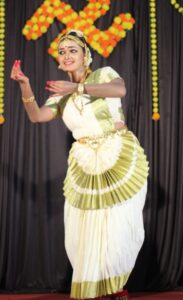WHO AM I and how I became a classical dancer?
Hi, I am Vandana, a Mohiniyattam dancer — the classical dance form of Kerala known for its grace and beauty.
I hold a B.A. degree in Mohiniyattam from RLV Govt College of Music and Fine Arts. Through my performances, I aim to share the elegance and tradition of this beautiful art form with others.
With love and dedication, I continue to learn, perform, and keep the spirit of Mohiniyattam alive.

My Story
My name is Vandana, and I am a professional Mohiniyattam dancer. From the time I was a small child, I loved to dance. When I was in Class+ 2, I did not know anything about courses or colleges, but I knew that dancing made me very happy. I felt that dance was my life.
When I reached my Plus Two (Higher Secondary) studies, I came to know that there was a college in Tripunithura called RLV College . Someone told me that in this college, there was a degree course in Mohiniyattam. I was really surprised. I thought, “Is it true? Can someone really take a degree in Mohiniyattam?” Until then, I had no idea that such an opportunity was possible. That moment gave me a new dream — I wanted to study more in that college, because dance was my life.
After finishing Plus Two, I joined RLV College to study Mohiniyattam. It was one of the happiest and most important decisions of my life. I practiced every day, studied hard, and lived my dream as a student of Mohiniyattam. Many people around me were surprised. They asked, “Oh, you are studying a degree in Mohiniyattam?” For them, it was unusual. But for me, it was the best decision, because I wanted nothing more than to dedicate my life to dance.
I continued my journey step by step, and finally, I graduated from RLV College with a degree in Mohiniyattam. That moment was very special for me. I felt proud and grateful, because my childhood dream had become true.
Now I am happy to say that I am a professional Mohiniyattam dancer. I want to perform more, study more, and also teach more, so that others can learn and experience this beautiful art form. Dance is not only my passion, but also my identity. It is what makes me who I am.
My dream is to continue performing on many stages, sharing the beauty of Mohiniyattam with audiences everywhere, and keeping the spirit of this graceful tradition alive for future generations.
History of Mohiniyattam
Mohiniyattam is one of the classical dance forms of Kerala, known for its soft movements, graceful steps, and expressions full of emotion. The word “Mohini” means an enchantress or a charming woman, and “attam” means dance. Together, it means “the dance of the enchantress.”
The roots of Mohiniyattam go back many centuries. In old texts and temple records, we can see that this dance was performed in temples of Kerala as an offering to the gods. It was not just entertainment – it was considered a spiritual experience. The dance was mostly performed by women, and it told stories from Hindu epics like the Ramayana, Mahabharata, and Bhagavata Purana.
During the 18th and 19th centuries, Mohiniyattam got strong support from kings of Kerala, especially from Swathi Thirunal Rama Varma, the king of Travancore. He encouraged many art forms, and under his care, Mohiniyattam became more polished, with proper songs and structure.
However, during colonial times, like many temple arts, Mohiniyattam also faced decline. It lost its glory for some years. But in the 20th century, great teachers and artists worked hard to bring it back. Gurus like Kalamandalam Kalyanikutty Amma, known as the “Mother of Mohiniyattam,” played a huge role in reviving and shaping the style we see today.
Now, Mohiniyattam is performed on big stages all over the world. It is taught in schools, academies, and universities. The dance is admired for its slow, circular movements, graceful costumes, and the way it shows emotions through eyes and face.
Lorem ipsum dolor sit amet, consectetur adipiscing elit. Ut elit tellus, luctus nec ullamcorper mattis, pulvinar dapibus leo.
